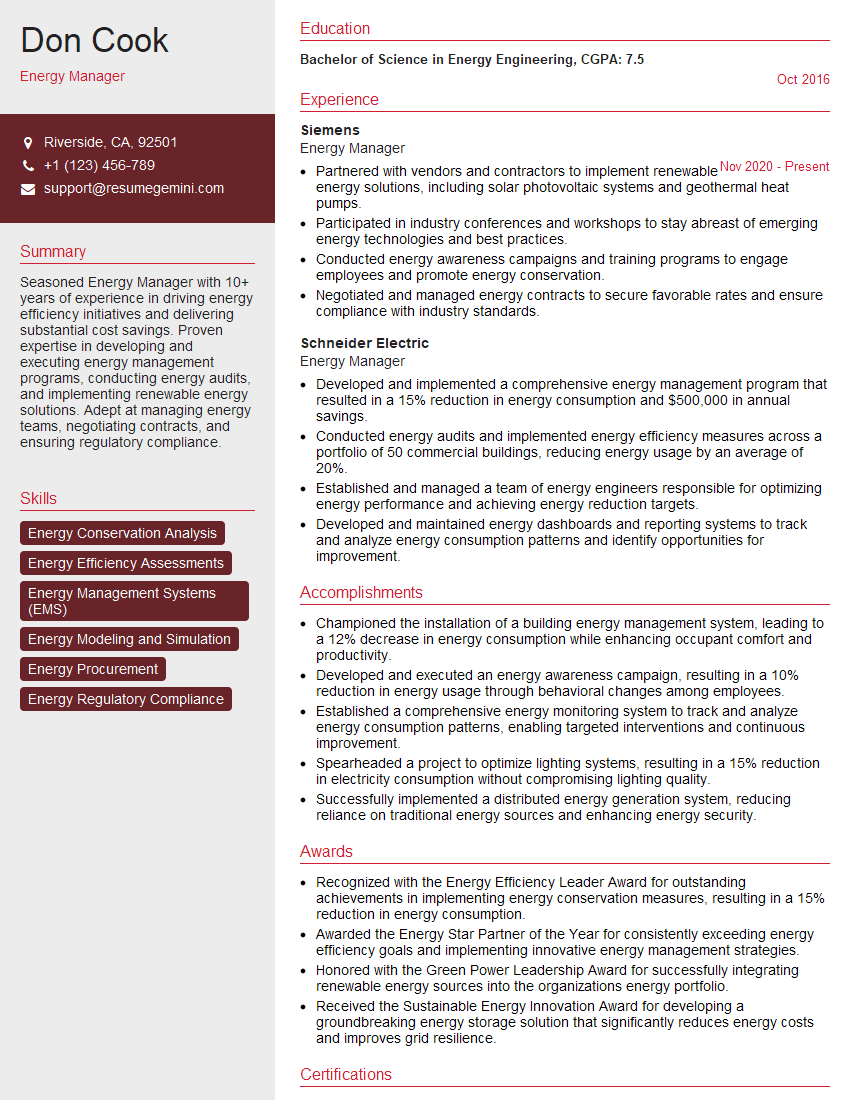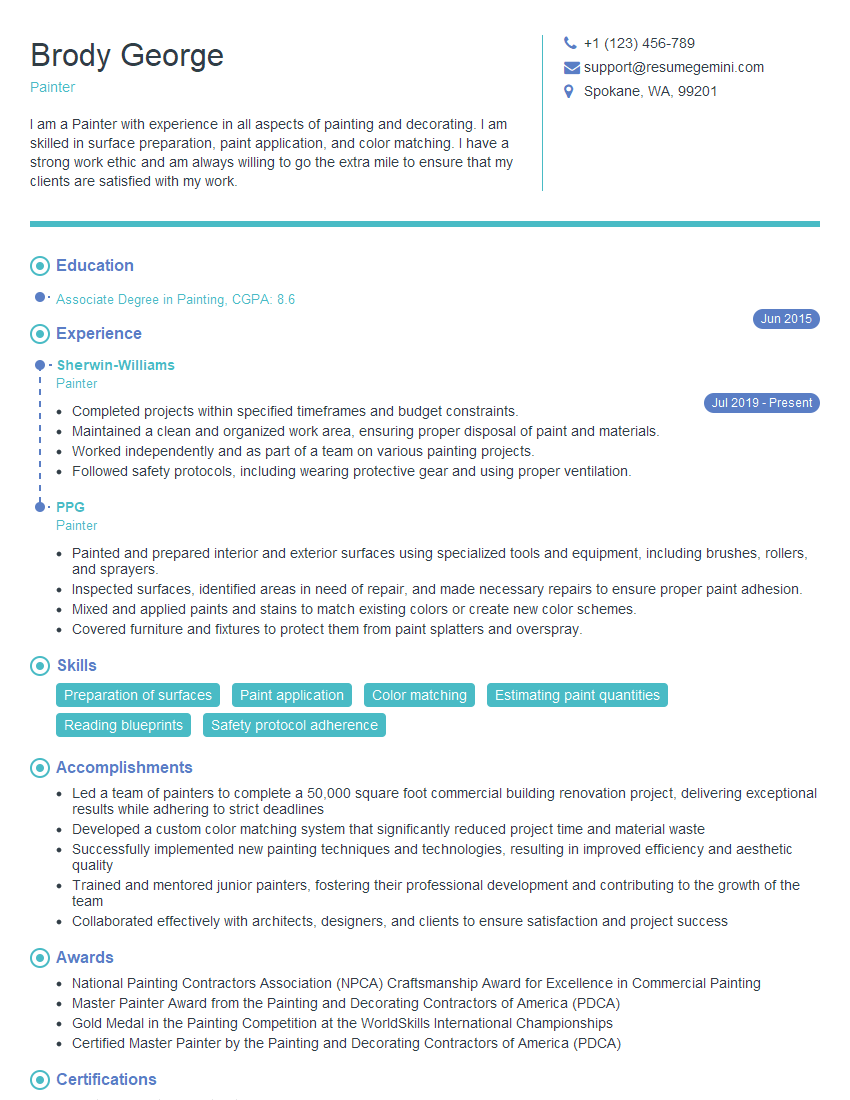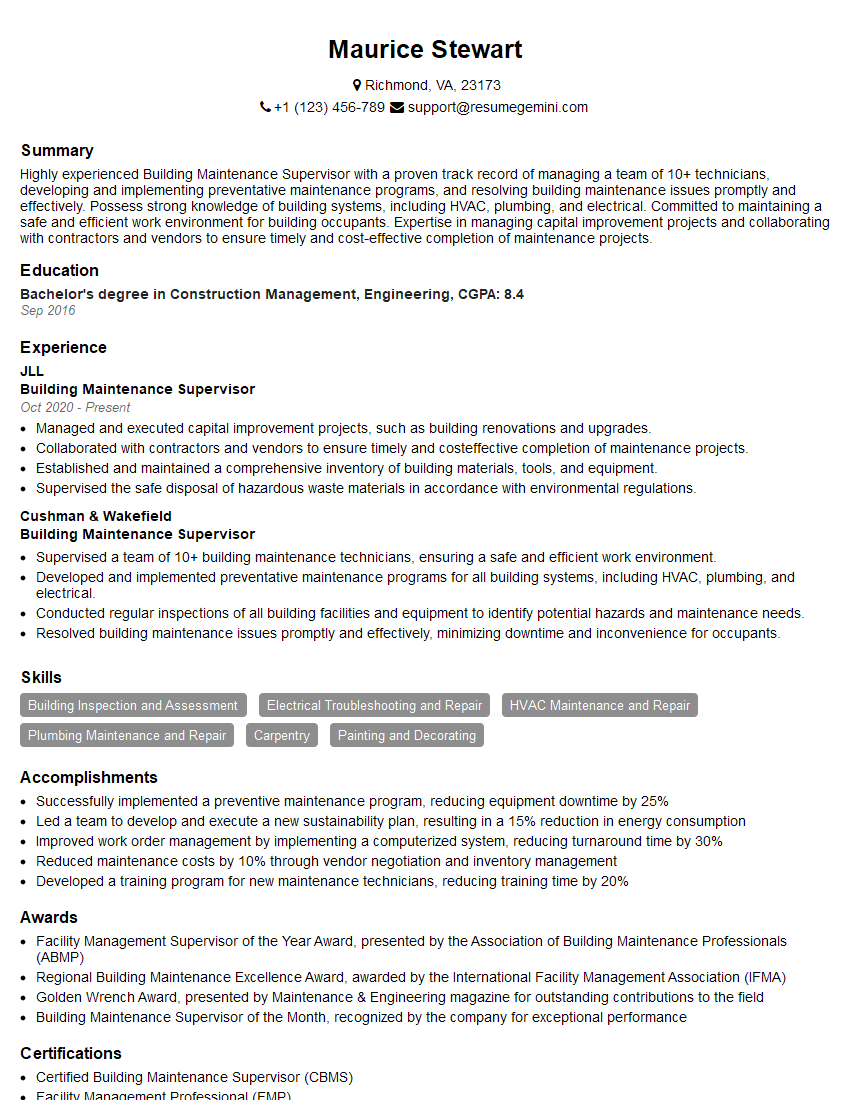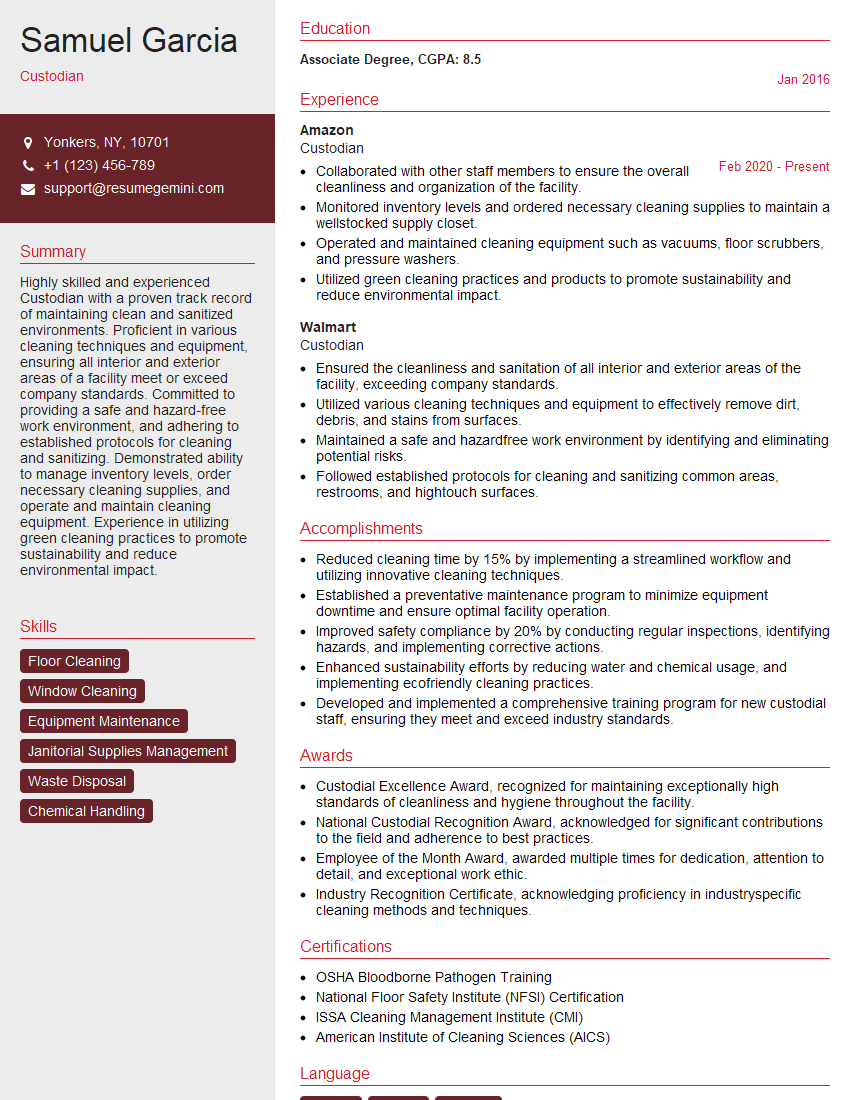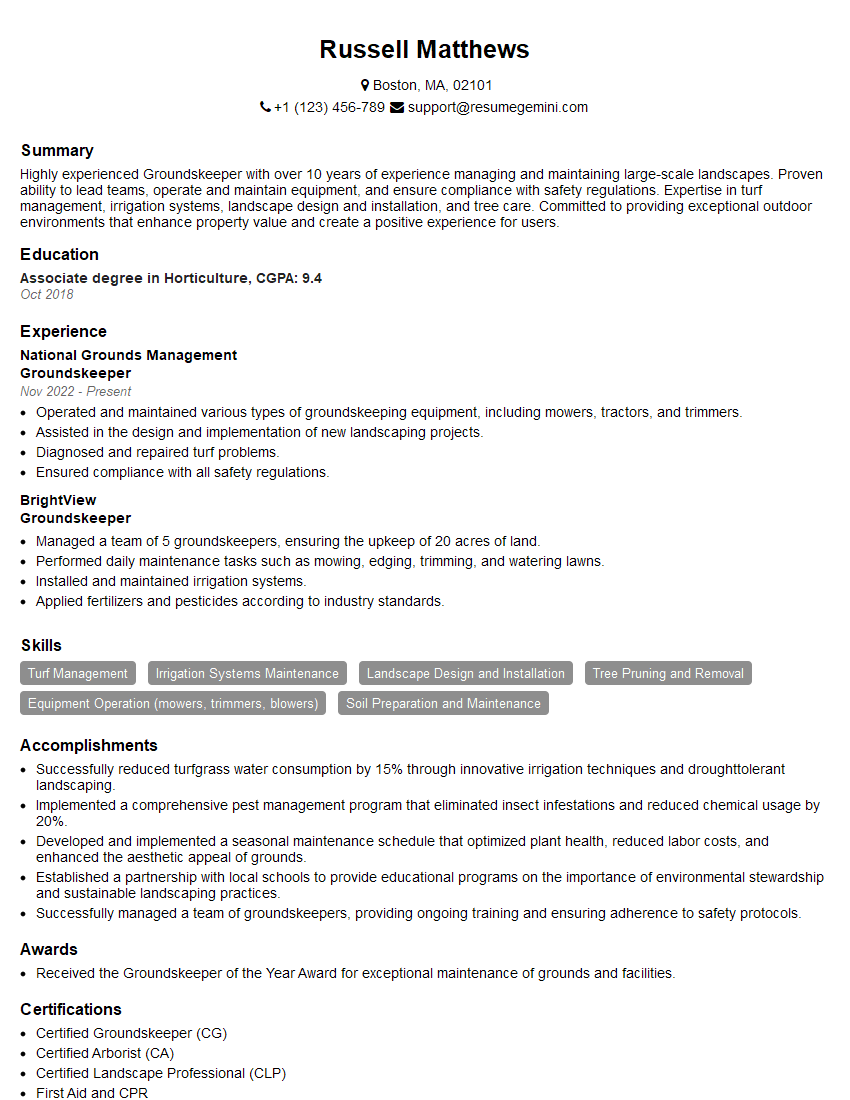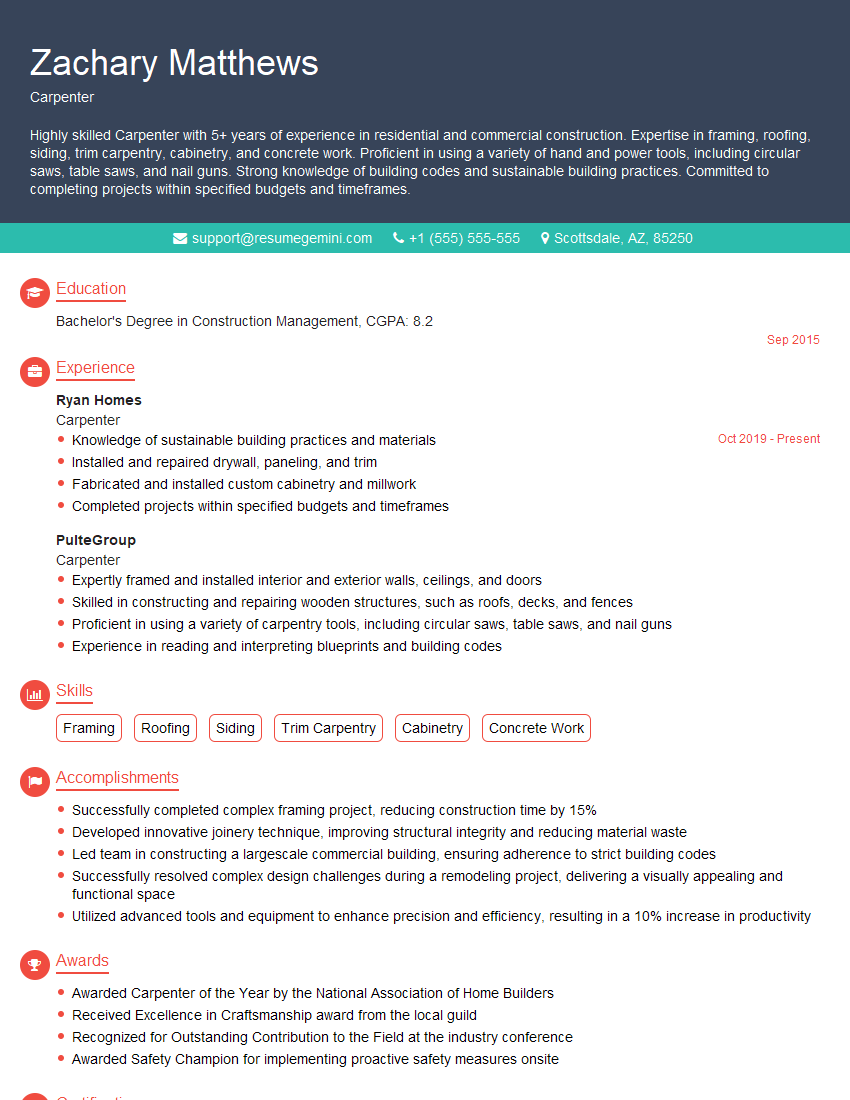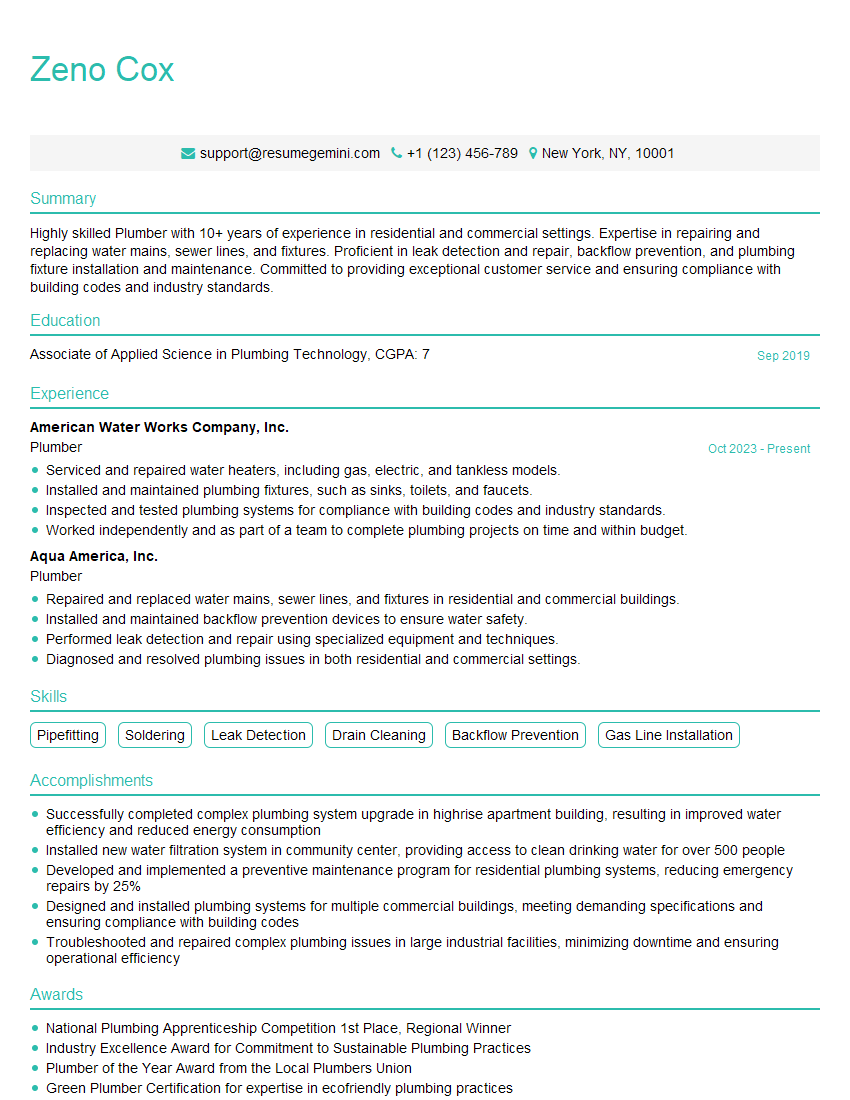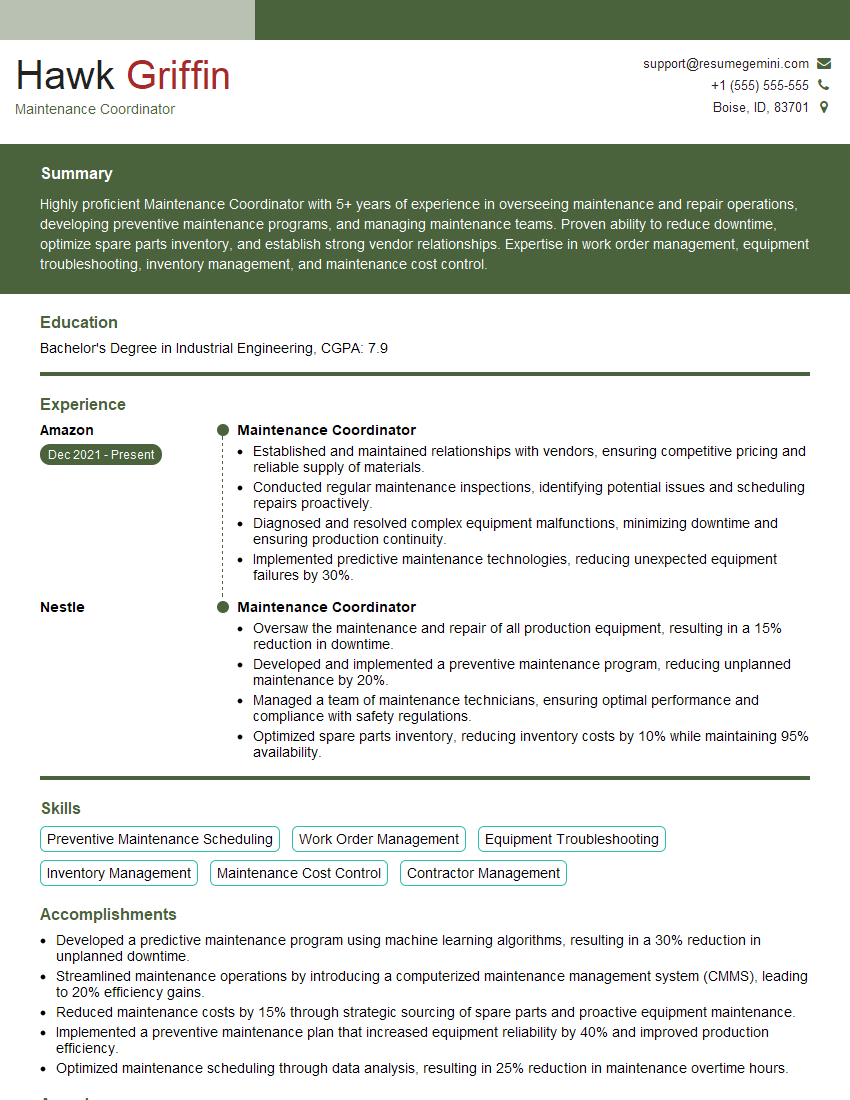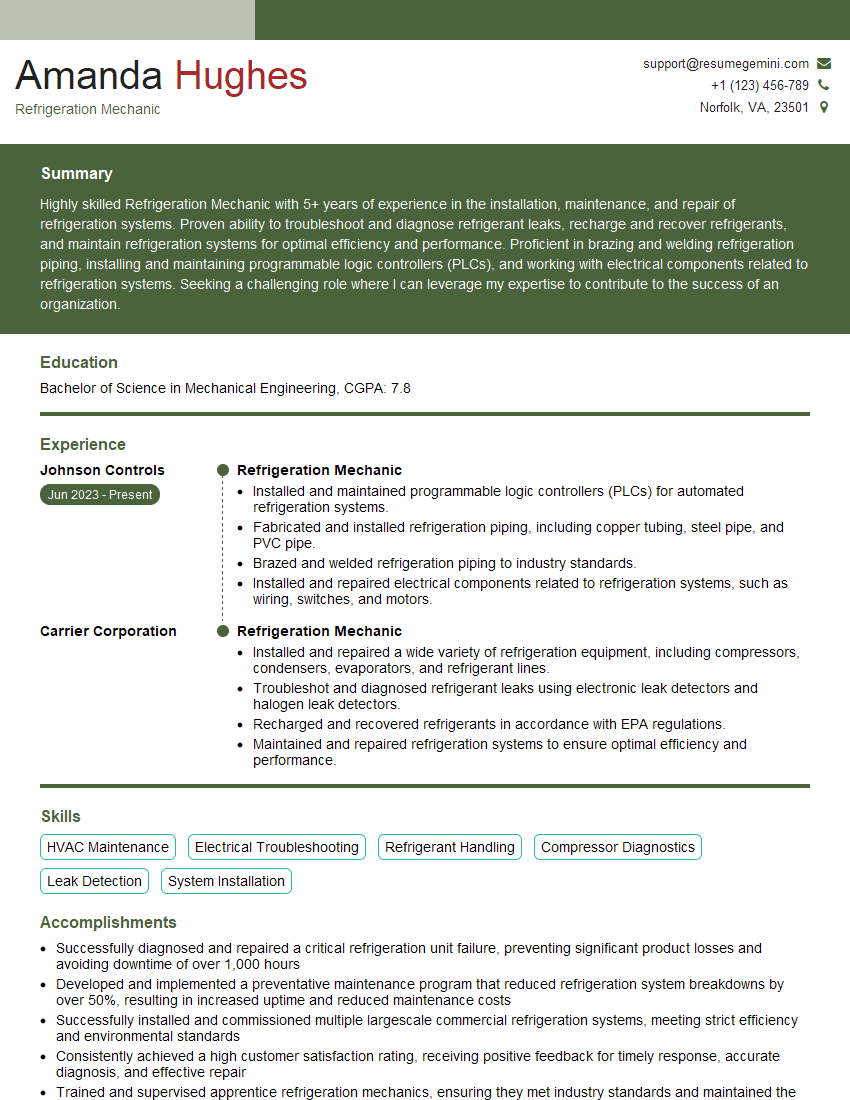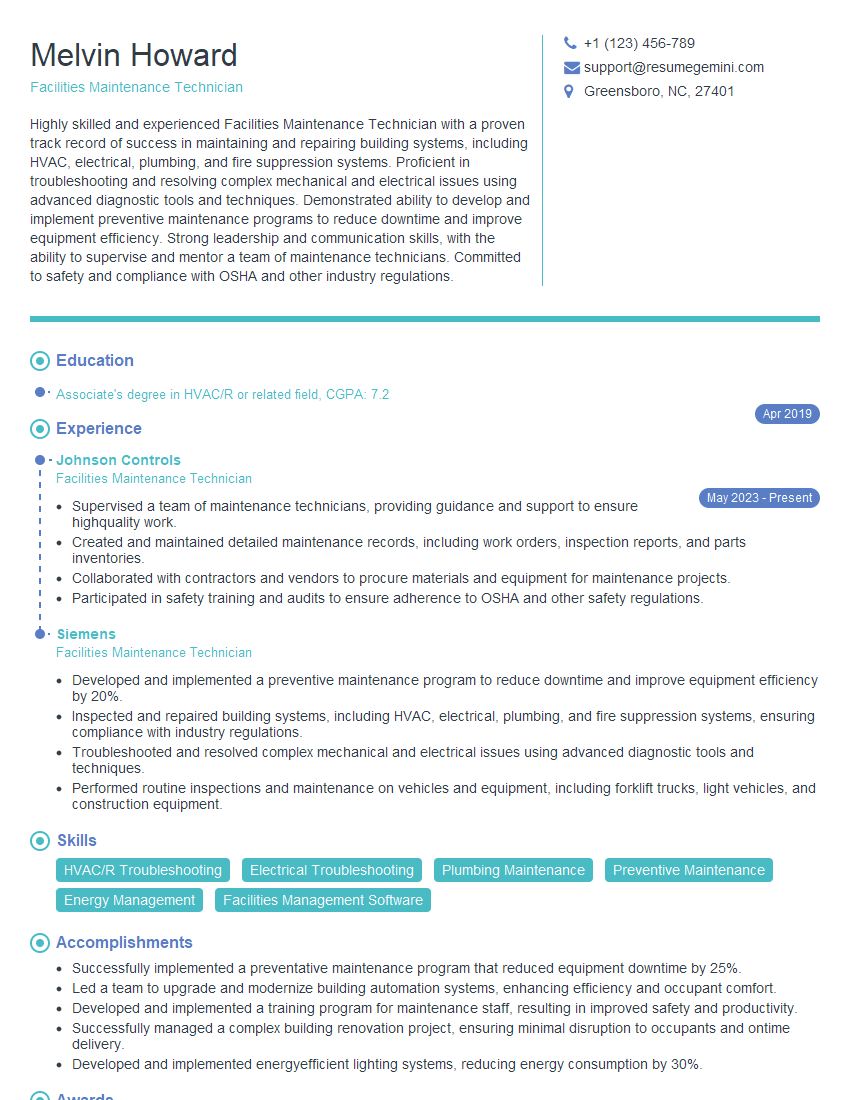Feeling uncertain about what to expect in your upcoming interview? We’ve got you covered! This blog highlights the most important Physical Plant Maintenance interview questions and provides actionable advice to help you stand out as the ideal candidate. Let’s pave the way for your success.
Questions Asked in Physical Plant Maintenance Interview
Q 1. Describe your experience with preventative maintenance programs.
Preventative maintenance (PM) is the cornerstone of a reliable and efficient physical plant. It focuses on proactively identifying and addressing potential issues before they escalate into costly breakdowns. My experience spans over 15 years, encompassing the development, implementation, and optimization of PM programs across various facilities, from small office buildings to large manufacturing plants.
- Developing PM Programs: I’ve led the creation of comprehensive PM schedules based on equipment manufacturers’ recommendations, historical data analysis (identifying failure trends), and risk assessments. This involved categorizing equipment based on criticality, establishing maintenance intervals (e.g., monthly checks, annual overhauls), and defining specific tasks for each inspection.
- Implementing PM Programs: Successful implementation requires strong communication and training. I’ve trained technicians on proper procedures, provided them with necessary tools and documentation, and implemented robust tracking systems to ensure compliance and record-keeping.
- Optimizing PM Programs: PM programs are not static; they need continuous refinement. I regularly review PM data, analyzing equipment performance and identifying areas for improvement. For example, adjusting maintenance intervals based on actual equipment lifespan or streamlining procedures to increase efficiency. One instance involved analyzing chiller PM data, which revealed unnecessary filter changes, leading to a 15% reduction in PM costs.
Q 2. How do you prioritize maintenance tasks in a high-pressure environment?
Prioritizing maintenance tasks in a high-pressure environment requires a structured approach. I utilize a combination of techniques, including a criticality assessment and a risk-based approach.
- Criticality Assessment: I categorize equipment and systems based on their criticality to operations. For instance, HVAC in a hospital operating room is far more critical than a restroom light fixture. This prioritization ensures that critical equipment receives immediate attention.
- Risk-Based Approach: This involves assessing the potential impact of a failure and its likelihood. A system with a high likelihood of failure and a significant impact (e.g., a main power generator) will be prioritized over a system with a low likelihood of failure and minor impact (e.g., a seldom-used water fountain).
- Using CMMS Software: Effective CMMS software (as discussed later) is crucial for prioritizing tasks. Work orders are generated, assigned, and tracked, allowing for efficient scheduling and resource allocation. The software often includes features for automated prioritization based on predefined rules and criteria.
- Regular Communication: In a high-pressure environment, open communication is vital. I keep stakeholders informed of progress, potential delays, and any critical issues requiring immediate action. Transparency fosters trust and ensures everyone is aligned.
Q 3. Explain your experience with troubleshooting HVAC systems.
My HVAC troubleshooting experience encompasses a wide range of issues, from minor component repairs to complex system diagnostics. I’m proficient in identifying and resolving problems across various HVAC systems, including chillers, boilers, air handling units (AHUs), and ventilation systems.
- Systematic Approach: I follow a structured approach to troubleshooting, starting with visual inspections, checking system logs, and reviewing operational data. This helps quickly identify potential problems, eliminating guesswork. For example, if a chiller is underperforming, I’d first check refrigerant pressures, cooling tower water flow, and condenser fan operation.
- Diagnostic Tools: I utilize various diagnostic tools, such as pressure gauges, temperature sensors, amp meters, and specialized HVAC analyzers, to pinpoint the root cause of malfunctions. For instance, a refrigerant leak can be detected using electronic leak detectors.
- Understanding System Dynamics: Troubleshooting HVAC systems requires a deep understanding of thermodynamics, refrigeration cycles, and control systems. For example, understanding how a change in condenser water temperature can impact chiller efficiency helps identify underlying issues quickly.
- Component Repair and Replacement: I’m experienced in repairing and replacing various HVAC components, including compressors, pumps, fans, motors, and control valves. This practical experience ensures efficient repairs and minimizes downtime.
Q 4. What is your experience with CMMS software (e.g., IBM Maximo, SAP PM)?
I have extensive experience with CMMS software, primarily IBM Maximo and SAP PM. These systems are indispensable for managing maintenance operations efficiently and effectively.
- Work Order Management: I’ve used these systems to generate, track, and manage work orders, ensuring that tasks are assigned to the appropriate technicians and completed on time. This includes creating preventative maintenance schedules, scheduling reactive repairs, and managing inventory.
- Data Analysis and Reporting: The software provides valuable data regarding equipment performance, maintenance costs, and technician productivity. I utilize this data to identify trends, optimize maintenance strategies, and make informed decisions regarding equipment replacement.
- Inventory Management: CMMS systems allow for efficient inventory management, reducing downtime caused by missing parts or materials. I’ve used the system to track inventory levels, automate reordering, and manage spare parts.
- Customization and Integration: I’ve worked on customizing CMMS systems to meet specific organizational needs, integrating them with other software systems such as accounting and procurement platforms to enhance efficiency.
Q 5. Describe your experience with electrical systems maintenance and repair.
My experience in electrical systems maintenance and repair includes both low-voltage and high-voltage systems. I’m familiar with all aspects, from routine inspections to complex repairs and upgrades.
- Safety Procedures: Safety is paramount when working with electrical systems. I strictly adhere to lockout/tagout procedures and other safety protocols to prevent electrical shock and injury. This includes thorough understanding of NFPA 70E (Standard for Electrical Safety in the Workplace).
- Troubleshooting Electrical Faults: I’m proficient in using diagnostic tools such as multimeters, clamp meters, and insulation testers to identify and rectify electrical faults, including short circuits, open circuits, and ground faults. For example, a multimeter is used to check voltage, current, and resistance.
- Wiring and Circuitry: I’m experienced in reading electrical schematics, wiring diagrams, and performing tasks such as installing new circuits, replacing faulty wiring, and troubleshooting complex electrical systems. This includes understanding different types of wiring, such as conduit, raceway, and cable tray systems.
- Equipment Repair and Maintenance: I’m familiar with the maintenance and repair of various electrical equipment, such as motors, transformers, circuit breakers, and switchgear.
Q 6. How do you manage a team of maintenance technicians?
Managing a team of maintenance technicians requires strong leadership, communication, and organizational skills. My approach focuses on fostering a collaborative and efficient work environment.
- Delegation and Empowerment: I delegate tasks based on each technician’s skills and experience, empowering them to take ownership of their work. This increases their sense of responsibility and improves overall productivity.
- Training and Development: I invest in the training and development of my team, providing opportunities for skill enhancement and career advancement. This includes providing on-the-job training, sending them to workshops, or sponsoring professional certifications.
- Performance Management: I conduct regular performance reviews to track individual progress, provide constructive feedback, and identify areas for improvement. This helps maintain high standards and motivates team members.
- Communication and Teamwork: I foster open communication and teamwork through regular team meetings, encouraging collaboration and knowledge sharing among technicians. This builds camaraderie and creates a supportive work environment.
- Safety Emphasis: Safety is a top priority. I ensure my team is properly trained in safety procedures and consistently uses appropriate safety equipment and practices.
Q 7. What is your experience with plumbing systems maintenance and repair?
My experience with plumbing systems maintenance and repair encompasses a wide range of tasks, from routine inspections to complex repairs and installations.
- Troubleshooting Plumbing Issues: I’m proficient in identifying and resolving various plumbing issues, such as leaks, clogs, low water pressure, and malfunctioning fixtures. This involves using tools like drain snakes, pressure gauges, and leak detectors.
- Pipe Repair and Replacement: I’m experienced in repairing and replacing various types of pipes, including PVC, copper, and cast iron. This includes understanding different pipe joining methods, such as soldering, solvent welding, and threading.
- Fixture Repair and Installation: I can repair and install various plumbing fixtures, such as toilets, sinks, faucets, and showerheads. This includes understanding the proper installation procedures and ensuring functionality.
- Water Heater Maintenance: I’m familiar with the maintenance and repair of water heaters, including flushing sediment, inspecting components, and addressing potential leaks or malfunctions.
- Backflow Prevention: I understand the importance of backflow prevention and am knowledgeable about installing and maintaining backflow prevention devices to protect the potable water supply.
Q 8. Explain your knowledge of building codes and safety regulations.
Building codes and safety regulations are the cornerstone of responsible physical plant maintenance. My understanding encompasses a wide range, including the International Building Code (IBC), local fire codes, OSHA regulations (Occupational Safety and Health Administration), and ADA compliance (Americans with Disabilities Act). These codes dictate everything from electrical safety and plumbing requirements to accessibility standards and emergency exits. For example, I’m intimately familiar with the requirements for sprinkler system maintenance and testing, ensuring they are regularly inspected and functioning correctly to prevent fire hazards. Similarly, I’m well-versed in lockout/tagout procedures for electrical work, minimizing the risk of electrocution during repairs. Regularly updating my knowledge on these evolving regulations is critical to ensure building safety and prevent potential liabilities.
- IBC: Covers structural integrity, fire protection, and accessibility.
- Fire Codes: Specific regulations for fire prevention, detection, and suppression systems.
- OSHA: Focuses on worker safety and health, including hazard identification and mitigation.
- ADA: Ensures accessibility for people with disabilities.
Q 9. How do you handle emergency maintenance requests?
Emergency maintenance requests require immediate and decisive action. My approach involves a tiered response system. First, I assess the urgency of the situation – is it a life safety issue (e.g., fire, flooding), a critical operational disruption (e.g., power outage impacting essential services), or a less urgent problem? This assessment dictates the prioritization and speed of response. For life-safety emergencies, I immediately dispatch the appropriate team, coordinating with building security and potentially emergency services. For critical operational disruptions, I activate pre-planned emergency protocols, potentially mobilizing specialized contractors. Less urgent issues are triaged and scheduled efficiently. I use a computerized maintenance management system (CMMS) to log and track all emergency requests, facilitating quick responses and maintaining detailed records for analysis and future improvements.
For instance, in a past role, we experienced a sudden boiler failure during a severe winter storm. Following our established protocol, I mobilized our emergency team, contacted a specialized boiler repair company, and ensured the building remained warm through temporary measures while awaiting the repair. Effective communication with building occupants was crucial in this scenario.
Q 10. Describe your experience with budgeting and cost control in maintenance.
Budgeting and cost control are integral to effective physical plant maintenance. My experience includes developing comprehensive annual budgets, forecasting maintenance expenses, tracking actual spending against the budget, and implementing cost-saving measures. I use various techniques, including zero-based budgeting, which requires justifying every expense, and activity-based costing, which links costs to specific maintenance activities. This detailed approach allows for informed decision-making regarding capital improvements and routine maintenance. I also leverage data analytics to identify trends in maintenance costs, predict potential issues, and optimize resource allocation. For example, by analyzing historical data, we discovered a pattern of recurring plumbing issues in a specific wing of the building, leading us to proactively budget for pipe replacement, preventing more costly repairs down the line.
Q 11. What is your experience with energy efficiency measures in buildings?
Energy efficiency is a top priority in modern building maintenance. I have extensive experience implementing various measures to reduce energy consumption and lower operating costs. This includes upgrading to energy-efficient lighting (LEDs), optimizing HVAC (Heating, Ventilation, and Air Conditioning) systems through preventative maintenance and smart controls, and implementing building automation systems (BAS) to monitor and manage energy usage in real-time. For instance, I oversaw the installation of a new BAS in a previous role, resulting in a 15% reduction in energy consumption within the first year. This involved not only the technical implementation but also educating building occupants on energy-saving practices.
Furthermore, I’m familiar with energy audits, which provide detailed assessments of energy usage and identify opportunities for improvement. Understanding and applying techniques such as building envelope improvements (insulation, window upgrades) are also essential in minimizing energy waste.
Q 12. How do you track and manage maintenance inventory?
Tracking and managing maintenance inventory is crucial for efficient operations and cost control. I rely heavily on a CMMS (Computerized Maintenance Management System) to maintain accurate records of all parts, supplies, and equipment. The CMMS allows for real-time tracking of inventory levels, automated reordering based on pre-defined thresholds, and detailed reporting on inventory usage and costs. Implementing a robust inventory management system involves regular physical inventory counts to verify accuracy, establishing clear procedures for receiving and issuing supplies, and setting up a system for managing obsolete or surplus items. This ensures that we have the necessary parts on hand to address maintenance needs promptly and avoid costly delays. For example, we implemented a barcode system to track inventory, dramatically reducing discrepancies and improving efficiency.
Q 13. How do you ensure compliance with environmental regulations?
Compliance with environmental regulations is paramount in physical plant maintenance. My experience includes ensuring adherence to local, state, and federal regulations regarding waste disposal, hazardous materials handling, and emissions control. This involves implementing proper procedures for handling hazardous waste, such as asbestos abatement, lead paint removal, and chemical storage. We utilize licensed contractors for hazardous material removal and maintain detailed records of all activities. Regular training for staff on environmental regulations and safe practices is essential. For example, I developed and implemented a comprehensive hazardous waste management plan, ensuring compliance with all applicable regulations and minimizing environmental impact.
Q 14. Describe your experience with contract management for maintenance services.
Contract management for maintenance services is a key aspect of my role. This includes developing clear and concise service agreements, selecting qualified contractors through a competitive bidding process, overseeing contractor performance, ensuring compliance with contract terms, and resolving any disputes. I utilize a formal contract management system to track key performance indicators (KPIs), ensuring that contractors meet the agreed-upon service levels. This system allows for regular performance reviews and proactive issue resolution. For instance, when contracting for HVAC maintenance, we establish clear KPIs, such as response times to service requests and equipment uptime, and regularly monitor the contractor’s performance against these metrics. Transparent and well-defined contracts are essential for successful partnerships.
Q 15. What is your experience with root cause analysis of maintenance issues?
Root cause analysis (RCA) is crucial for effective Physical Plant Maintenance. It’s not enough to just fix a problem; we need to understand why it happened to prevent recurrence. My approach involves a systematic investigation, often using methods like the 5 Whys, Fishbone diagrams, or Fault Tree Analysis.
For example, if a boiler keeps malfunctioning, simply replacing a faulty part isn’t sufficient. Using the 5 Whys, we might ask:
- Why did the boiler malfunction? (Low water pressure)
- Why was the water pressure low? (Leaking valve)
- Why was the valve leaking? (Corrosion)
- Why did the valve corrode? (Lack of regular inspection and preventative maintenance)
- Why were inspections insufficient? (Inadequate staffing or training).
This process reveals the underlying issue – insufficient preventative maintenance – allowing us to implement corrective actions like improved inspection schedules and staff training, ultimately preventing future boiler malfunctions. I’ve successfully used this approach numerous times to resolve recurring issues, resulting in significant cost savings and improved operational efficiency.
Career Expert Tips:
- Ace those interviews! Prepare effectively by reviewing the Top 50 Most Common Interview Questions on ResumeGemini.
- Navigate your job search with confidence! Explore a wide range of Career Tips on ResumeGemini. Learn about common challenges and recommendations to overcome them.
- Craft the perfect resume! Master the Art of Resume Writing with ResumeGemini’s guide. Showcase your unique qualifications and achievements effectively.
- Don’t miss out on holiday savings! Build your dream resume with ResumeGemini’s ATS optimized templates.
Q 16. How do you develop and implement maintenance procedures?
Developing and implementing maintenance procedures requires a structured approach. It starts with a thorough understanding of the equipment or system involved, including its operating principles, critical components, and potential failure points. This information is gathered through manufacturer documentation, site surveys, and consultations with operating personnel.
Then, I develop a detailed procedure, including:
- Safety precautions: This is paramount. Procedures must prioritize safety for personnel and the facility.
- Tools and materials needed: A comprehensive list prevents delays.
- Step-by-step instructions: Clear, concise, and unambiguous instructions are essential for consistent execution.
- Inspection checklists: These ensure completeness and quality control.
- Frequency of maintenance: This is determined based on factors like equipment usage, manufacturer recommendations, and historical data.
Once developed, procedures are documented, reviewed by relevant stakeholders, and disseminated to maintenance staff through training and accessible documentation. Regular updates based on experience and technological advancements are crucial for ongoing improvement. I’ve found that using visual aids like flowcharts and diagrams significantly enhances understanding and reduces errors.
Q 17. What is your experience with the use of diagnostic tools and equipment?
Proficiency with diagnostic tools and equipment is essential for effective maintenance. My experience encompasses a wide range of tools, from basic multimeters and infrared thermometers to sophisticated vibration analyzers, thermal imagers, and specialized software for analyzing equipment data.
For example, using a vibration analyzer, I can detect early signs of bearing wear in a pump before it fails catastrophically. Similarly, thermal imaging can pinpoint electrical faults or insulation deficiencies before they cause a fire hazard. I’m adept at interpreting the data generated by these tools to accurately diagnose problems and guide effective repair strategies. Staying up-to-date on the latest technology is a priority, allowing me to consistently choose the right tool for the job and improve diagnostic accuracy.
Q 18. Describe your experience with project management related to maintenance projects.
My project management experience in maintenance includes everything from small repairs to large-scale renovations. I utilize established project management methodologies, like Agile or Waterfall, tailoring the approach to the specific project’s needs. This involves:
- Project planning and scoping: Defining clear objectives, timelines, and budgets.
- Resource allocation: Ensuring the right personnel, materials, and equipment are available.
- Risk management: Identifying potential problems and developing mitigation strategies.
- Communication and coordination: Maintaining clear communication among all stakeholders.
- Progress monitoring and reporting: Tracking progress against the plan and providing regular updates.
One recent project involved upgrading the HVAC system in a large office building. Through careful planning and coordination, we completed the project on time and under budget, minimizing disruption to building occupants. Effective project management ensures successful completion of maintenance projects, minimizing downtime and maximizing resource utilization.
Q 19. How do you handle difficult or challenging situations in maintenance?
Handling challenging situations requires a calm, systematic approach. This involves:
- Assessing the situation: Quickly understanding the nature and severity of the problem.
- Prioritizing tasks: Identifying the most critical issues and addressing them first.
- Seeking assistance when necessary: Not being afraid to ask for help from colleagues or outside experts.
- Maintaining clear communication: Keeping stakeholders informed of progress and any potential delays.
- Documenting everything: Creating a record of the problem, the steps taken, and the outcome for future reference.
For example, a sudden power outage during a critical event required immediate action. By prioritizing emergency procedures, effectively coordinating with the electrical contractor, and communicating transparently with building occupants, we restored power quickly, minimizing disruption and damage.
Q 20. Explain your knowledge of different types of building materials and their maintenance.
My knowledge of building materials and their maintenance is extensive. I understand the properties, strengths, weaknesses, and maintenance requirements of various materials, including:
- Concrete: Requires regular inspection for cracking, spalling, and reinforcement corrosion. Maintenance may involve patching, sealing, or structural repairs.
- Steel: Prone to rust and corrosion. Maintenance involves regular painting, coating, or cathodic protection.
- Wood: Susceptible to rot, insect infestation, and weathering. Maintenance includes regular inspections, treatment with preservatives, and repairs.
- Masonry: Requires regular cleaning, pointing (re-filling mortar joints), and repair of damaged units.
Understanding these materials’ properties allows for the development of appropriate maintenance schedules and the selection of suitable repair techniques. For instance, knowing that certain types of wood are more resistant to rot enables informed material selection for exterior applications, thus reducing long-term maintenance costs.
Q 21. How familiar are you with building automation systems (BAS)?
Building Automation Systems (BAS) are integral to modern physical plant management. My familiarity encompasses various aspects of BAS, including:
- Monitoring and control: Using BAS to monitor various building systems (HVAC, lighting, security) and adjust their operation to optimize energy efficiency and occupant comfort.
- Troubleshooting and diagnostics: Utilizing BAS data to diagnose equipment malfunctions and identify areas for improvement.
- Data analysis: Interpreting data from BAS to identify trends and patterns that can inform maintenance strategies and improve operational efficiency.
- System integration: Understanding how different building systems interact and how the BAS can integrate them for better performance.
I’m experienced with various BAS platforms and protocols, enabling me to effectively use the system to manage and optimize the building’s performance. For example, by analyzing energy consumption data from the BAS, I was able to identify inefficient equipment and implement upgrades that resulted in significant energy savings.
Q 22. Describe your experience with fire safety systems maintenance.
My experience with fire safety systems maintenance encompasses a wide range of responsibilities, from preventative maintenance to emergency response. Preventative maintenance includes regularly scheduled inspections of fire alarm systems, sprinkler systems, fire extinguishers, and emergency lighting. This involves testing the functionality of each component, ensuring proper signage, and documenting all findings. I’m proficient in troubleshooting malfunctions, identifying potential hazards, and implementing corrective actions, adhering strictly to NFPA (National Fire Protection Association) codes and local regulations. For example, in my previous role, I led a project to upgrade our outdated fire alarm system to a digitally addressable system, significantly improving our response time and reducing false alarms. Emergency response involves coordinating with the fire department during actual incidents, ensuring the safety of building occupants, and assisting in post-incident investigations.
Furthermore, I possess a deep understanding of different types of fire suppression systems, their limitations, and optimal maintenance schedules. This includes familiarity with wet pipe, dry pipe, pre-action, and deluge systems. My experience extends to working with various fire detection technologies, such as ionization, photoelectric, and heat detectors, understanding their strengths and weaknesses and how to maintain optimal performance.
Q 23. What are your strategies for improving maintenance efficiency?
Improving maintenance efficiency is a continuous process that requires a multi-pronged approach. My strategies center around three key areas: proactive maintenance planning, effective resource allocation, and leveraging technology. Proactive maintenance involves shifting from reactive repairs to scheduled preventative maintenance. This reduces downtime, extends the lifespan of equipment, and ultimately lowers costs. I use Computerized Maintenance Management Systems (CMMS) to schedule tasks, track work orders, and monitor equipment performance. For example, using predictive maintenance techniques, like vibration analysis on critical machinery, allows us to anticipate failures before they occur.
Effective resource allocation involves optimizing workforce scheduling, prioritizing tasks based on urgency and impact, and ensuring technicians have the right tools and training. This requires meticulous data analysis and a clear understanding of our maintenance workload. Leveraging technology involves adopting CMMS software, utilizing mobile devices for work order management, and exploring automation opportunities for repetitive tasks. For instance, implementing a system that automatically generates work orders based on equipment usage hours can significantly improve efficiency.
Q 24. How do you communicate effectively with building occupants regarding maintenance?
Effective communication with building occupants is paramount for maintaining a positive and productive environment. My strategy involves multiple channels to ensure everyone is informed and their concerns are addressed promptly. Firstly, I utilize clear and concise signage to announce planned maintenance activities, including the duration and potential disruptions. Secondly, I leverage email communication for broader announcements, and targeted emails for specific issues or concerns. For instance, before a scheduled power outage, I would send an email to all occupants notifying them of the time, duration and the reason for the outage.
Thirdly, I make myself available for direct communication through regular meetings, open forums, or a dedicated communication channel. This approach fosters transparency and creates opportunities for feedback. Finally, I document all communication, including maintenance requests, resolutions, and any feedback received, ensuring accountability and a comprehensive record. Maintaining a transparent and responsive communication system builds trust and ensures a positive relationship between the maintenance team and building occupants.
Q 25. Describe a time you had to deal with a significant maintenance failure.
During a severe winter storm, a major water pipe burst in the building’s basement, causing significant flooding and damage. This was a critical failure as it compromised the building’s structural integrity and affected essential services, including heating and electricity. My immediate response involved activating our emergency response plan, which included contacting emergency services, securing the area, and evacuating affected areas. We then assessed the damage, identified the source of the leak, and implemented temporary solutions to mitigate further damage while simultaneously initiating repairs.
The process of repair involved contacting specialized contractors, managing the procurement of necessary materials, and coordinating the repair work while minimizing disruption to building occupants. The experience highlighted the importance of thorough preventative maintenance, a robust emergency response plan, and the value of strong relationships with reliable contractors. Following the incident, we implemented improved preventative maintenance strategies for our plumbing infrastructure, and updated our emergency response plan, incorporating lessons learned from this significant failure. We also conducted a thorough review of building insurance to ensure adequate coverage for future emergencies.
Q 26. What is your approach to training new maintenance technicians?
Training new maintenance technicians is a crucial part of ensuring high-quality work and a consistent level of service. My approach is multifaceted, combining classroom instruction, hands-on experience, and mentorship. Classroom instruction focuses on the fundamentals of building systems, safety regulations, and the use of specialized tools and equipment. I utilize interactive learning methods, including case studies and simulations, to promote knowledge retention. For example, we might use a simulated HVAC system to practice troubleshooting and repair procedures in a safe and controlled environment.
Hands-on experience is gained through shadowing experienced technicians, performing routine maintenance tasks under supervision, and participating in progressively complex repairs. Mentorship is an integral part of the training program, pairing each new technician with an experienced mentor who provides guidance, support, and feedback. This personalized approach fosters professional growth and ensures that technicians develop practical skills and best practices. The program culminates in a comprehensive evaluation to assess their competence and readiness to work independently.
Q 27. How do you stay up-to-date on the latest maintenance technologies and practices?
Staying up-to-date on the latest maintenance technologies and practices is essential for maintaining a competitive edge and providing optimal service. I achieve this through a combination of professional development activities, industry publications, and networking. I regularly attend industry conferences and workshops, where I learn about new technologies, best practices, and emerging trends. For instance, I recently attended a conference focusing on the implementation of IoT sensors for predictive maintenance, which has significantly altered our preventative maintenance scheduling.
I subscribe to industry-leading journals and online publications to stay informed about the latest advancements. I also actively participate in professional organizations, such as the Association of Facilities Engineering (AFE), to network with peers and stay connected to the latest developments. Furthermore, I actively seek out opportunities for continuing education, including online courses and certifications, to expand my knowledge and skills in specific areas. This commitment to ongoing professional development ensures I remain at the forefront of the field and consistently apply the most effective and efficient methods.
Q 28. Describe your experience with developing and managing a maintenance budget.
Developing and managing a maintenance budget requires careful planning, meticulous tracking, and a thorough understanding of both current and projected needs. I start by forecasting annual maintenance costs based on historical data, equipment lifecycles, and anticipated repairs. This includes detailed cost estimates for labor, materials, contracts, and other expenses. I categorize expenses to facilitate tracking and analysis. For instance, I might separate expenses into categories such as HVAC, plumbing, electrical, and preventative maintenance.
Throughout the year, I carefully monitor actual expenditures against the budget, using the CMMS to track work orders and associated costs. This allows for timely identification and correction of any variances. Regular budget reviews are conducted to assess the effectiveness of cost controls and to identify potential areas for improvement or reallocation of resources. These reviews often involve collaborating with stakeholders to ensure alignment with organizational priorities and budgetary constraints. By implementing proactive maintenance strategies and carefully monitoring spending, I strive to balance cost-effectiveness with the need to maintain a high standard of building functionality and safety.
Key Topics to Learn for Physical Plant Maintenance Interview
- Preventive Maintenance Programs: Understanding the principles of preventative maintenance, scheduling, and implementing effective programs to minimize downtime and extend equipment lifespan. Practical application includes developing and optimizing a preventative maintenance schedule for a specific piece of equipment.
- HVAC Systems: Knowledge of heating, ventilation, and air conditioning systems, including troubleshooting common issues, understanding system components (compressors, coils, etc.), and performing basic maintenance tasks. Practical application includes describing your experience diagnosing and repairing a malfunctioning HVAC unit.
- Electrical Systems: Familiarity with basic electrical principles, safety procedures, troubleshooting electrical faults, and understanding different types of electrical systems within a building. Practical application includes explaining your approach to identifying and resolving an electrical power outage.
- Plumbing Systems: Understanding the principles of plumbing, identifying leaks, performing basic repairs, and knowledge of different piping systems. Practical application includes describing your experience troubleshooting a plumbing issue, such as a clogged drain or a leaking pipe.
- Building Codes and Regulations: Familiarity with relevant building codes and safety regulations related to maintenance and repairs. Practical application includes describing how you ensure compliance with building codes during your work.
- Safety Procedures and Practices: Demonstrating a strong understanding of safety protocols, including lockout/tagout procedures, personal protective equipment (PPE) usage, and hazard identification. Practical application includes describing a situation where you prioritized safety in a maintenance task.
- Budgeting and Resource Management: Understanding the importance of cost-effective maintenance strategies and efficient resource allocation. Practical application includes describing how you’ve managed a maintenance budget or prioritized tasks based on resource availability.
- Problem-Solving and Troubleshooting: Demonstrating systematic problem-solving skills, including identifying the root cause of equipment malfunctions and implementing effective solutions. Practical application includes describing your approach to diagnosing and resolving a complex maintenance issue.
- Communication and Teamwork: Highlighting your ability to communicate effectively with colleagues, supervisors, and other stakeholders, as well as your experience working collaboratively on maintenance projects. Practical application includes describing a situation where you effectively collaborated with others to resolve a maintenance issue.
Next Steps
Mastering Physical Plant Maintenance opens doors to a rewarding career with excellent growth potential, offering opportunities for specialization and advancement within facilities management. To maximize your job prospects, create an ATS-friendly resume that showcases your skills and experience effectively. ResumeGemini is a trusted resource to help you build a professional and impactful resume that stands out to employers. We provide examples of resumes tailored specifically to Physical Plant Maintenance positions to guide you through the process.
Explore more articles
Users Rating of Our Blogs
Share Your Experience
We value your feedback! Please rate our content and share your thoughts (optional).
What Readers Say About Our Blog
This was kind of a unique content I found around the specialized skills. Very helpful questions and good detailed answers.
Very Helpful blog, thank you Interviewgemini team.





